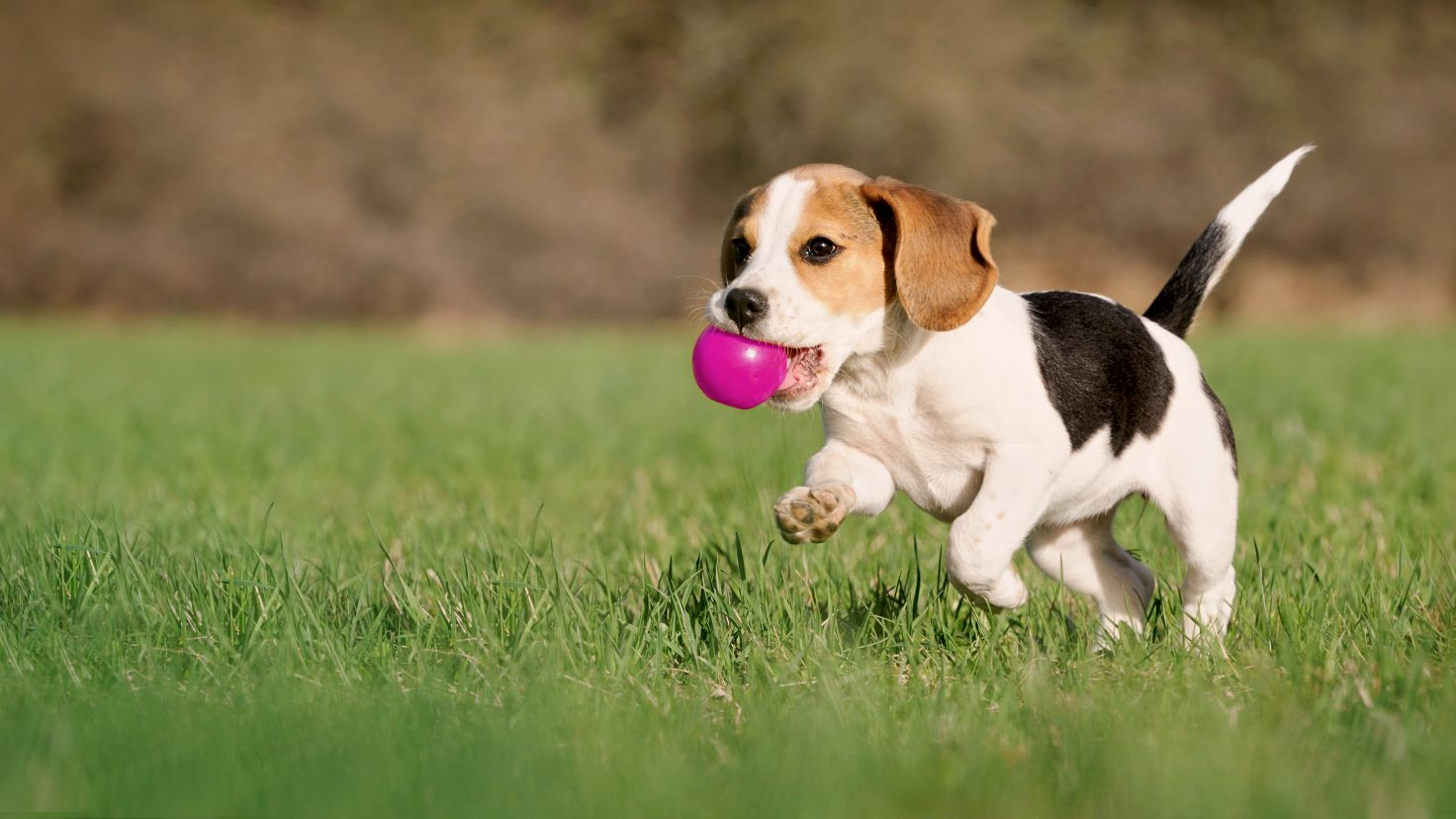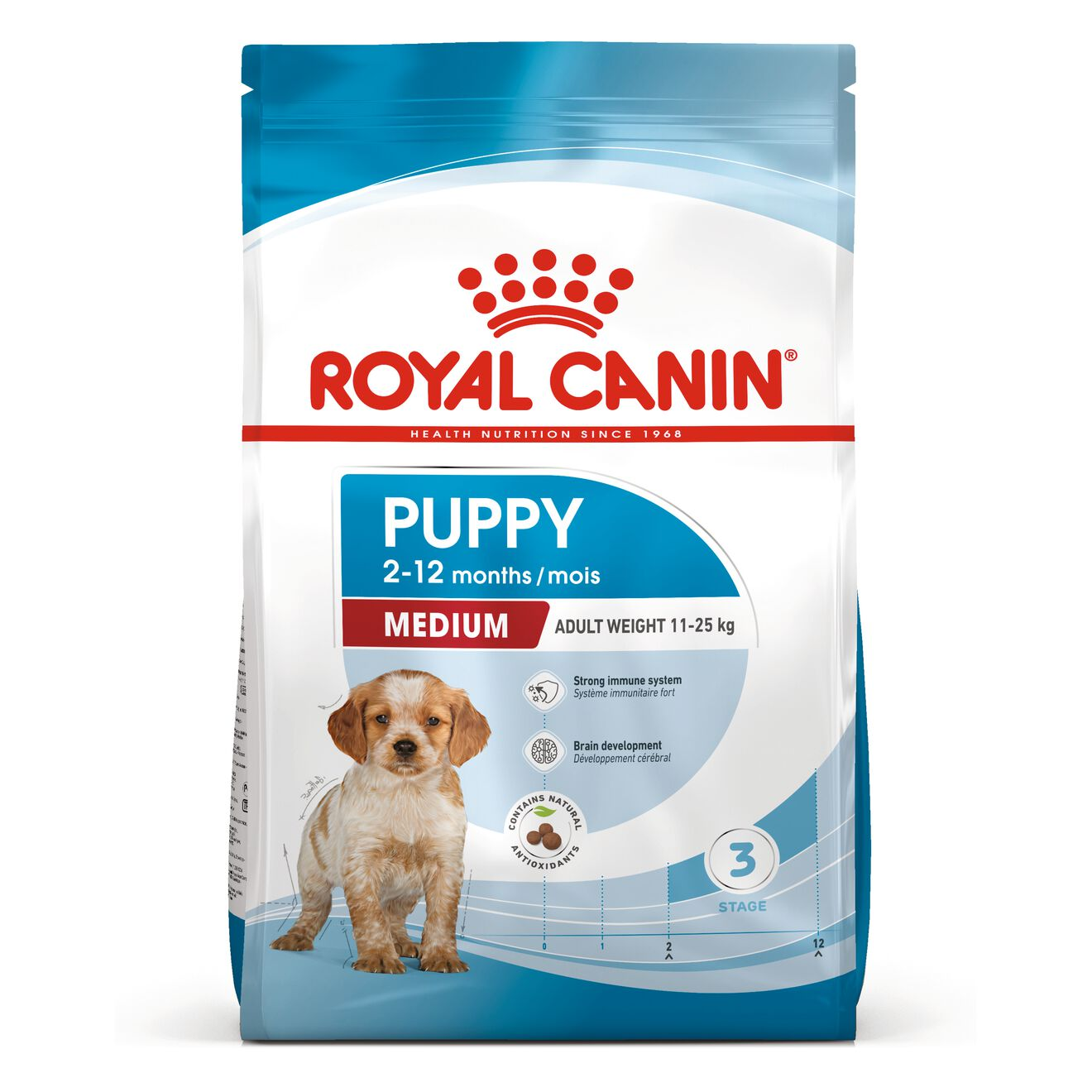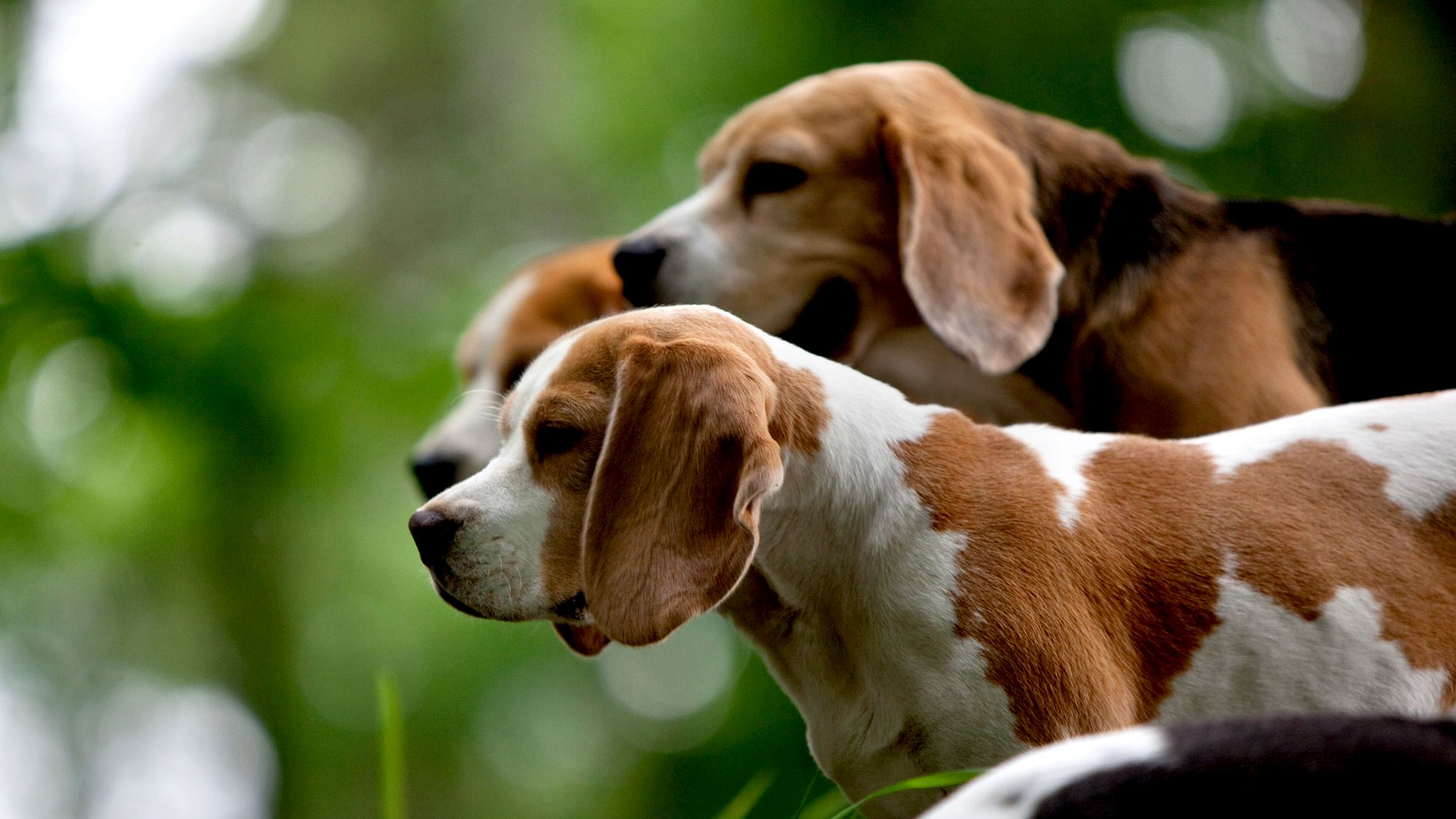Причајмо о бигловима
Званично име: Бигл
Остала имена: Хаунд, енглески бигл
Порекло: Уједињено Краљевство
Склоност ка балављењу
2 out of 5Потреба за одржавањем длаке
1 out of 5Степен лињања
3 out of 5Склоност лајању
5 out of 5Ниво енергије*
5 out of 5Уклапање са другим кућним љубимцима
4 out of 5Топло време?
3 out of 5Хладно време?
1 out of 5Погодан за живот у стану?
3 out of 5Може ли да остане сам?*
1 out of 5Породични љубимац?*
4 out of 5
| Мушки | Женски |
|---|---|
| Висина | Висина |
| 33 - 38 cm | 30.5 - 33 cm |
| Тежина | Тежина |
| 9 - 13 kg | 9 - 10 kg |
| Животна фаза | |
|---|---|
| Узраст штенета | Одрасло доба |
| 2 до 12 месеци | 12 месеци до 7 година |
| Старије доба | Старије доба |
| 7 до 10 година | 10 до 20 година |
| Доба младунчета | |
| Од рођења до 2. месеца | |
Склоност ка балављењу
2 out of 5Потреба за одржавањем длаке
1 out of 5Степен лињања
3 out of 5Склоност лајању
5 out of 5Ниво енергије*
5 out of 5Уклапање са другим кућним љубимцима
4 out of 5Топло време?
3 out of 5Хладно време?
1 out of 5Погодан за живот у стану?
3 out of 5Може ли да остане сам?*
1 out of 5Породични љубимац?*
4 out of 5
| Мушки | Женски |
|---|---|
| Висина | Висина |
| 33 - 38 cm | 30.5 - 33 cm |
| Тежина | Тежина |
| 9 - 13 kg | 9 - 10 kg |
| Животна фаза | |
|---|---|
| Узраст штенета | Одрасло доба |
| 2 до 12 месеци | 12 месеци до 7 година |
| Старије доба | Старије доба |
| 7 до 10 година | 10 до 20 година |
| Доба младунчета | |
| Од рођења до 2. месеца | |

Упознајте бигла
Све што треба да знате о раси
Са својим изразом лица који приличи псићима, опуштеним ушима и изражајним очима, није ни чудо што су биглови једна од омиљенијих раса паса у свету. Нежни и опуштени, имају и диван темперамент – а уз мало дресуре, бигл се одлично слаже са децом и другим животињама.
Иако порекло бигла није прецизно познато, сматра се да су са нама више стотина година. Верује се да потичу од ловачких паса старих Римљана, а постали су популарни у Британији током 1800-их. Године 1890. Клуб бигла је основан и убрзо је уследио стандард.
Данас, је бигл један од 10 најпопуларнијих паса на свету, према Америчком кинолошком клубу. Такође се редовно појављује на нашим екранима. Имао је главне улоге у свему, од серије са ликовима од пластелина Волис и Громит и хит ТВ емисије Чудесне године до дечијег филма Шилох. Приметно, ту је и Снупи, најпознатији бигл од свих који су се појавили у стрипу Кикирики (Peanuts).
Са својим црвенкастим, црно-белим крзном, бигл је по изгледу сличан лисичару – иако је овај други много већи. Такође, у оквиру саме расе биглова, постоје две различите варијанте. Амерички кинолошки клуб прави разлику између оних испод 13 инча у висини рамена и оних између 33 и 38 цм – иако у Великој Британији они могу бити мало већи.
Са прилично чврстом конституцијом, малтезер је здрава раса паса са добрим животним веком. Заиста, многи малтезери доживе касне тинејџерске године – а повремено и преко тога.
Активни и енергични, бигловима ће бити потребно најмање сат времена активности сваког дана, али идеално више. Одгајани за лов у чопорима, такође им је боље у друштву и не прија им да буду остављени сами.
Још једно упозорење пре него што изаберете бигла: воле звук сопственог гласа и могу бити познати по томе да лају и оглашавају се прилично често. Они такође имају тенденцију да буду мало изазовнији за дресуру од појединих раса, али ништа што се не може превазићи уз неколико посластица и мало стрпљења.
Све у свему, ове верне животиње су одлични љубимци. У ствари, уз мало уложеног труда, ускоро ћете бити награђени новим најбољим пријатељем.

2 чињенице о бигловима
1. Прати траг
Заједно са гоничем Светог Хуберта и басетом, бигл има једно од најбоље развијених чула мириса од свих раса паса. Заправо, они имају око 220 милиона рецептора мириса у свом носу.
2. Све иде у рок службе
С обзиром на њихово одлично чуло мириса, не чуди што многи биглови раде као пси за откривање на аеродромима. Обично се користе за њушење експлозива и наркотика, али, у скорије време, они су такође обучени да открију присуство корона вируса.
1.Глава
2.Лице
3.Крзно
4.Тело
5.Реп
Историја расе
Упркос многим нагађањима међу љубитељима паса, порекло бигла остаје донекле обавијено велом мистерије. Ипак, по свој прилици, они вероватно потичу од римских ловачких паса који су били навикли да хватају зечеве и слично. Осим тога, појављивали су се на сликама и у књижевности још од елизабетанских времена.
Тада је било мањих, оштродлаких биглова – од којих су неки били толико мали да су се могли носити у џепу ловачке јакне. Величина бигла је порасла током година, али мање верзије расе, познате као „џепни биглови“, постоје и данас.
Док је тачно порекло назива бигла изгубљено у времену, многи верују да реч потиче од галског израза „беаг“ (мали). Други сугеришу да потиче од француског израза за прасак ловачких рогова („be’geule“).
У сваком случају, модерна раса бигла сматра се да се појавила у Великој Британији око 1830-их. Верује се да је укрштање неколико раса – укључујући вероватно талбота, бигла северне земље и јужног гонича – бигл личност као да комбинује најбоље карактеристике у једном.
Године 1890, Клуб бигла је основан у УК и убрзо је уследио стандард расе. Данас, бигл се редовно појављује на листама омиљених раса широм света.
С обзиром на биглово добро понашање, његову величину и послушни темперамент, то је и омиљена раса за лабораторије. Срећом, многе добротворне организације раде на томе да им понуде дом. Размишљате ли да набавите бигла? Зашто да не претворите лабораторијског пса у пса за лежање у крилу?
Од главе до репа
Физичке карактеристике бигла

Ствари на које треба пазити
Од специфичних особина расе до општег здравственог прегледа, ево неколико занимљивих чињеница о биглу
Важно је изабрати одобреног одгајивача
Док бигл углавном има прилично добар животни век, са просечном очекиваном старошћу од 12 до 15 година, он током година може бити склон одређеним генетским здравственим стањима – баш као и све расе паса. Као и увек, кључно је купити од одговорног и угледног одгајивача, јер ће он извршити проверу на већину наследних стања, што ће помоћи да се смање ризици. Такође, ако знате да ли је ваш бигл носилац, или би потенцијално могао развити здравствене проблеме касније, може помоћи вама и вашем ветеринару да планирате његову доживотну негу.
Пазите на проблеме са очима
Раса бигл паса такође може бити склона проблемима са видом попут глаукома, дегенеративног поремећаја познатог као прогресивна атрофија ретине (PRA) и стања по имену аденом трећег капка у ком жлезда почиње да се пробија у углу. Као што је често са овим стварима, рано откривање може бити јако важно. Имајући то на уму, важно је да редовно проверавате очи вашег бигла и да консултујете ветеринара ако има неке необичне симптоме или знаке нелагодности. Поред тога, свеобухватан офталмолошки преглед се препоручује за вашег бигла два пута годишње.
Ово је раса која такође може бити подложна епилепсији
Покренуто абнормалном електричном активношћу у мозгу, ово неуролошко стање може резултирати благим или понекад тешким нападима. Други симптоми се могу показати као посртање, падање или привремена дезоријентација. Једно од најчешћих стања које се виђа код биглова, епизоде се могу појавити од око шестог месеца старости. Иако може бити забрињавајуће присуствовати нападима, они изгледају много горе него што заиста јесу. Заправо, дугорочна прогноза за псе који пате од епилепсије обично је прилично позитивна. Као и увек, најбоље је разговарати о стварима са ветеринаром који ће моћи да вам препоручи одговарајући ток лечења вашег бигла.
Здрава исхрана, здравији пас

Када бирате храну за бигла, постоји много фактора које треба узети у обзир: његове године, начин живота, ниво активности, физичко стање и здравље, укључујући потенцијалне болести или осетљивост. Храна обезбеђује енергију за подмиривање виталних функција пса, а целокупна нутритивна формула треба да садржи прилагођену равнотежу хранљивих материја како би се избегао било какав недостатак или вишак у исхрани, при чему обе варијанте могу неповољно да утичу на пса. Чиста и свежа вода треба да буде на располагању у свако доба. По врућем времену, а нарочито при вежбању напољу, понесите воду за честе паузе вашег пса за пијење воде. Унос енергије ће увек морати да се прилагоди и климатским условима. Пас који зими живи на отвореном имаће повећане захтеве за енергијом.
Следеће препоруке су за здраве животиње. Ако ваш пас има здравствених проблема, потражите савет ветеринара који ће вам прописати ексклузивну ветеринарску дијету. Потребе штенета бигла, у смислу енергије, протеина, минерала и витамина, много су веће од потреба одраслог пса. Потребни су им енергија и хранљиве материје како би одржавали своје тело, али и да би расли и обликовали се. Док не на напуне 12 месеци, имуни систем штенаца бигла се развија постепено. Комплекс антиоксиданата – укључујући витамин Е – може помоћи у подршци његовој природној одбрани током овог времена великих промена, открића и нових сусрета. И његове дигестивне функције се разликују од одраслог бигла: његов систем за варење још увек није зрео па је важно обезбедити високо сварљиве протеине које ће се ефикасно искористити. Пребиотици, као што су фрукто-олигосахариди, подржавају здравље дигестивног тракта помажући у балансирању цревне флоре, што резултује добрим квалитетом столице.
Слично томе, зуби штенета – почев од млечних зуба, или првих зуба, па до сталних зуба – важан су фактор који треба узети у обзир приликом одабира величине, облика и текстуре гранула. Унос калорија треба контролисати јер су биглови познати су по својој тенденцији да се гоје. Препоручујемо да дневно следовање поделите на три оброка док не напуне шест месеци, а затим да пређете на два оброка дневно.

Главни нутритивни циљеви за одрасле биглове су:
Одржавање идеалне телесне тежине коришћењем високо сварљивих састојака и одржавањем садржаја масти на разумном нивоу
Подстицање оптималне пробаве са висококвалитетним протеинима и уравнотеженог уноса хранљивих влакана
Подршка здравим костима и зглобовима са хондроитином, глукозамином и EPA-DHA
Помаже у очувању здравља и лепоте коже и крзна са богатим додатком есенцијалних масних киселина (посебно EPA-DHA), есенцијалних аминокиселина и Б витамина.
Да бисте помогли његовој природној одбрани, препоручује се формула обогаћена антиоксидативним комплексом и која садржи манан-олигосахариде.

Након 7 година старости, биглови почињу да показују прве знаке старења. Формула обогаћена антиоксидансима ће помоћи у одржању њихове виталности, а специфични хранљиви састојци као што су хондроитин и глукозамин, помоћи ће у подршци здравим костима и зглобовима. Старење је такође праћено променама у пробавној способности и посебним нутритивним захтевима, те би храна за старије биглове требало да има следеће карактеристике:
Већи садржај витамина Ц и Е. Ове хранљиве материје имају антиоксидативна својства, штите телесне ћелије од штетног дејства оксидативног стреса повезаног са старењем.
Висококвалитетни протеини. Насупрот широко распрострањеној заблуди, снижавање садржаја протеина у храни доноси малу корист у ограничавању отказивања бубрега. Поред тога, старији пси су мање ефикасни у коришћењу хранљивих протеина од млађих паса. Смањење садржаја фосфора је добар начин да успорите постепено погоршање функције бубрега.
Већи однос елемената у траговима: гвожђа, цинка и мангана помаже одржавању доброг стања коже и крзна
Већа количина полинезасићених масних киселина (сојино уље, рибље уље) помаже у одржавању квалитета крзна. Пси нормално производе ове масне киселине, али старење може утицати на овај физиолошки процес.
Како старе, пси све више пате од проблема са зубима. Да бисте осигурали да ће наставити да једу у довољним количинама, потребно је прилагодити облик, величину и текстуру гранула вилици.
Током целог њиховог живота, важно је избегавати храњење биглова храном за људе или масним грицкалицама. Уместо тога, наградите их гранулама из њиховог следовања за оброк, и стриктно се придржавајте водича за храњење са паковања како бисте спречили прекомерно добијање на тежини.

Нега бигла
Савети за дотеривање, дресуру и вежбање
Биглови су обично атлетски и енергични пси који највише воле да добро проњушкају напољу. Стога би требало да имају најмање сат времена активности сваког дана – а идеално два или више. Старија одрасла јединка бигла може постати помало лења и задовољна да се ушушка у својој корпи, али пошто је ово раса која је склона гојазности, важно је да не дође до тога. Колико год да имају година, биглови и даље задржавају тај својствени ловачки инстинкт, са тенденцијом да јуре мирис, тако да ћете можда желети да их задржите на повоцу – или барем у видокругу. Такође, пошто су они савршени уметници за бекство, са вештином за копање испод ограда, важно је да их пажљиво пазите чак и код куће у дворишту.
Једна од многих позитивних страна поседовања бигла је што захтевају веома мало дотеривања. Иако имају густо дупло крзно, које их штити од непогода, њихова кратка, глатка и водоотпорна длака се лако чисти и одржава. Четкање бигла једном недељно четком средњих чекиња требало би да буде довољно да уклоните мртве длаке. Такође, лињање је само умерено до просечно, али ће бити обилније током сезона лињања бигла. Због кратког крзна, повремено купање би требало да буде више него довољно. Такође, нокте треба редовно сећи, зубе четкати што је могуће чешће, а биглове дугачке „спуштене“ уши треба пажљиво проверавати током дотеривања.
Када је у питању обука бигла, истина је да могу бити мало изазовнији од појединих раса. Немојте им рећи да смо вам то рекли. А, иако су нежни и посвећени пси, имају и независну црту. Због своје историје ловца, биглови ће желети да њуше све током шетњи – и може им бити потребно дуже од просека за обуку за живот у кући. Али, са друге стране, биглови такође врло брзо уче и добро ће реаговати на обуку засновану на награђивању – посебно ако она подразумева храну. Кључ је да обуку бигла започнете рано док је штене часовима и редовном социјализацијом. Уз мало планирања и стрпљења, обоје ћете уживати у наградама.
Биглови су обично атлетски и енергични пси који највише воле да добро проњушкају напољу. Стога би требало да имају најмање сат времена активности сваког дана – а идеално два или више. Старија одрасла јединка бигла може постати помало лења и задовољна да се ушушка у својој корпи, али пошто је ово раса која је склона гојазности, важно је да не дође до тога. Колико год да имају година, биглови и даље задржавају тај својствени ловачки инстинкт, са тенденцијом да јуре мирис, тако да ћете можда желети да их задржите на повоцу – или барем у видокругу. Такође, пошто су они савршени уметници за бекство, са вештином за копање испод ограда, важно је да их пажљиво пазите чак и код куће у дворишту.
Једна од многих позитивних страна поседовања бигла је што захтевају веома мало дотеривања. Иако имају густо дупло крзно, које их штити од непогода, њихова кратка, глатка и водоотпорна длака се лако чисти и одржава. Четкање бигла једном недељно четком средњих чекиња требало би да буде довољно да уклоните мртве длаке. Такође, лињање је само умерено до просечно, али ће бити обилније током сезона лињања бигла. Због кратког крзна, повремено купање би требало да буде више него довољно. Такође, нокте треба редовно сећи, зубе четкати што је могуће чешће, а биглове дугачке „спуштене“ уши треба пажљиво проверавати током дотеривања.
Када је у питању обука бигла, истина је да могу бити мало изазовнији од појединих раса. Немојте им рећи да смо вам то рекли. А, иако су нежни и посвећени пси, имају и независну црту. Због своје историје ловца, биглови ће желети да њуше све током шетњи – и може им бити потребно дуже од просека за обуку за живот у кући. Али, са друге стране, биглови такође врло брзо уче и добро ће реаговати на обуку засновану на награђивању – посебно ако она подразумева храну. Кључ је да обуку бигла започнете рано док је штене часовима и редовном социјализацијом. Уз мало планирања и стрпљења, обоје ћете уживати у наградама.
7/7
Све о бигловима
Остале расе које би вас могле занимати
Прочитајте више о овој теми
Извори
- Амерички ветеринарски центри https://vcahospitals.com/
- Royal Canin енциклопедија паса. Издање 2010. и 2020.
- Болница за кућне љубимце у Банфилду https://www.banfield.com/
- Royal Canin BHN књига производа
- Амерички кинолошки клуб https://www.akc.org/
Лајкуј и подели страницу